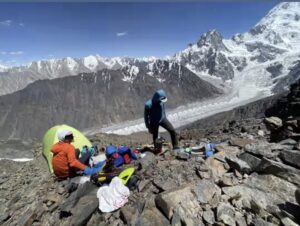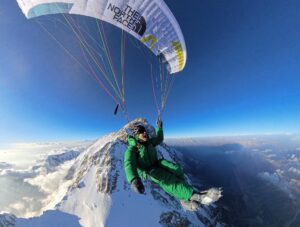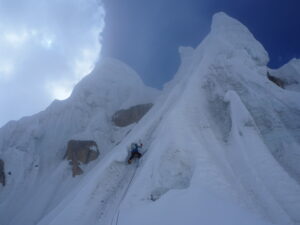From Skardu, Martin Sieberer spoke to ExplorersWeb about his and Simon Messner’s alpine-style first ascent of Yernamandu Kangri. The name means “the mountain of the upper Mandu Glacier.”

The west face of Yernamandu Kangri. Photo: Martin Sieberer
The climbers estimated that Yernamandu Kangri is 7,180m, which made of it one of the world’s highest unclimbed peaks. Moving alpine style up the west face, the pair took three days and two bivouacs to climb 3,000 vertical meters and about 20km in distance.
“The locals say it was probably the first successful [non-commercial] ascent of a higher mountain in the whole Karakoram this season,” said Sieberer. “The snow conditions are extra challenging this year.”
He also noted that they climbed the upper west face (600m, up to 70° alpine ice) without a rope. They had discarded their own rope to save weight.

Sieberer and Messner try to rest on very steep terrain.
The route difficulties started straight from base camp at 4,300m.
“To get to the main wall of Yernamandu Kangri, we had to find a way through both the lower glacier, which was full of seracs, and the upper Masherbrum Glacier,” Sieberer said. “The west face starts at about 6,500m and steepens up to 70º when you get higher.”
Short window
“Before the ascent, there was a lot of snowfall and bad weather,” he went on. “Then a short weather window of four days opened up. We seized it as our only option.”

Messner and Sieberer’s second bivouac on Yernamandu Kangri. Photo: Martin Sieberer
“The lower glacier had quite good snow,” Sieberer said. “We knew that because we had crossed it back and forth during acclimatization. However, the upper two-thirds of the ascent was mostly on poor snow, hard on top but loose below. We broke through the crust with every step, especially as we climbed higher.”
He added: “Also, we dealt with alpine ice up to the ridge at about 7,050m. Finally, we traversed to the summit ridge, where we topped out over easy mixed terrain and deep snow.”

The climbers on the summit. Photo: Simon Messner
In the end, Martin Sieberer and Simon Messner summited previously unclimbed Yernamandu Kangri, in the Masherbrum range of Pakistan’s Karakoram, on July 15 at 11:15 am.
In a later conversation about the route, Martin Sieberer confirmed they climbed Yernamandu from the southwest, aiming for the peak’s west face. But in the end, they accessed the ridge via the classic Masherbrum route, first climbed by Americans George Bell and Willi Unsoeld in 1960 via the southwest face.
“The route to the upper glacier it is probably the same route as the first ascent of Masherbrum,” Sieberer confirmed. “I guess there is only one semi-safe way to get up there. On the upper glacier, we went more to the right and then up to Yernamandu.”

Submitted by Martin Sieberer, the map shows the peak’s southwest face.





